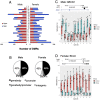DNA methylation profiles in the blood of newborn term infants born to mothers with obesity
- PMID: 35500004
- PMCID: PMC9060365
- DOI: 10.1371/journal.pone.0267946
DNA methylation profiles in the blood of newborn term infants born to mothers with obesity
Abstract
Maternal obesity is an important risk factor for childhood obesity and influences the prevalence of metabolic diseases in offspring. As childhood obesity is influenced by postnatal factors, it is critical to determine whether children born to women with obesity during pregnancy show alterations that are detectable at birth. Epigenetic mechanisms such as DNA methylation modifications have been proposed to mediate prenatal programming. We investigated DNA methylation signatures in male and female infants from mothers with a normal Body Mass Index (BMI 18.5-24.9 kg/m2) compared to mothers with obesity (BMI≥30 kg/m2). BMI was measured during the first prenatal visit from women recruited into the Ontario Birth Study (OBS) at Mount Sinai Hospital in Toronto, ON, Canada. DNA was extracted from neonatal dried blood spots collected from heel pricks obtained 24 hours after birth at term (total n = 40) from women with a normal BMI and women with obesity matched for parity, age, and neonatal sex. Reduced representation bisulfite sequencing was used to identify genomic loci associated with differentially methylated regions (DMRs) in CpG-dense regions most likely to influence gene regulation. DMRs were predominantly localized to intergenic regions and gene bodies, with only 9% of DMRs localized to promoter regions. Genes associated with DMRs were compared to those from a large publicly available cohort study, the Avon Longitudinal Study of Parents and Children (ALSPAC; total n = 859). Hypergeometric tests revealed a significant overlap in genes associated with DMRs in the OBS and ALSPAC cohorts. PTPRN2, a gene involved in insulin secretion, and MAD1L1, which plays a role in the cell cycle and tumor suppression, contained DMRs in males and females in both cohorts. In males, KEGG pathway analysis revealed significant overrepresentation of genes involved in endocytosis and pathways in cancer, including IGF1R, which was previously shown to respond to diet-induced metabolic stress in animal models and in lymphocytes in the context of childhood obesity. These preliminary findings are consistent with Developmental Origins of Health and Disease paradigm, which posits that adverse prenatal exposures set developmental health trajectories.
Conflict of interest statement
The authors have declared that no competing interests exist.
Figures



Similar articles
-
Maternal pre-pregnancy BMI, offspring epigenome-wide DNA methylation, and childhood obesity: findings from the Boston Birth Cohort.BMC Med. 2023 Aug 23;21(1):317. doi: 10.1186/s12916-023-03003-5. BMC Med. 2023. PMID: 37612641 Free PMC article.
-
Sex-specific DNA methylation signatures of autism spectrum disorder from whole genome bisulfite sequencing of newborn blood.Biol Sex Differ. 2025 Apr 30;16(1):30. doi: 10.1186/s13293-025-00712-9. Biol Sex Differ. 2025. PMID: 40307894 Free PMC article.
-
Offspring body size and metabolic profile - effects of lifestyle intervention in obese pregnant women.Dan Med J. 2014 Jul;61(7):B4893. Dan Med J. 2014. PMID: 25123127 Review.
-
Associations between prenatal physical activity, birth weight, and DNA methylation at genomically imprinted domains in a multiethnic newborn cohort.Epigenetics. 2015;10(7):597-606. doi: 10.1080/15592294.2015.1045181. Epub 2015 Apr 30. Epigenetics. 2015. PMID: 25928716 Free PMC article.
-
DNA methylation changes in cord blood and the developmental origins of health and disease - a systematic review and replication study.BMC Genomics. 2022 Mar 19;23(1):221. doi: 10.1186/s12864-022-08451-6. BMC Genomics. 2022. PMID: 35305575 Free PMC article.
Cited by
-
DNA methylation patterns in umbilical cord blood from infants of methadone maintained opioid dependent mothers.Sci Rep. 2024 Jul 27;14(1):17298. doi: 10.1038/s41598-024-66899-w. Sci Rep. 2024. PMID: 39068260 Free PMC article.
-
Genetics, epigenetics and transgenerational transmission of obesity in children.Front Endocrinol (Lausanne). 2022 Nov 14;13:1006008. doi: 10.3389/fendo.2022.1006008. eCollection 2022. Front Endocrinol (Lausanne). 2022. PMID: 36452324 Free PMC article. Review.
-
Obesity and Adipose Tissue Dysfunction: From Pediatrics to Adults.Genes (Basel). 2022 Oct 15;13(10):1866. doi: 10.3390/genes13101866. Genes (Basel). 2022. PMID: 36292751 Free PMC article. Review.
-
The Obesity-Epigenetics-Microbiome Axis: Strategies for Therapeutic Intervention.Nutrients. 2025 May 1;17(9):1564. doi: 10.3390/nu17091564. Nutrients. 2025. PMID: 40362873 Free PMC article. Review.
-
Cord blood DNA methylation of immune and lipid metabolism genes is associated with maternal triglycerides and child adiposity.Obesity (Silver Spring). 2024 Jan;32(1):187-199. doi: 10.1002/oby.23915. Epub 2023 Oct 23. Obesity (Silver Spring). 2024. PMID: 37869908 Free PMC article.
References
-
- Afshin A, Reitsma MB, Murray CJL (2017) Health Effects of Overweight and Obesity in 195 Countries. N Engl J Med 377: 1496–1497.
-
- Garn SM, Cole PE, Bailey SM (1979) Living together as a factor in family-line resemblances. Hum Biol 51: 565–587. - PubMed
-
- Rowe NH, Garn SM, Clark DC, Guire KE (1976) The effect of age, sex, race, and economic status on dental caries experience of the permanent dentition. Committee to Review the Ten-State Nutrition Survey of 1968–1970. Pediatrics 57: 457–461. - PubMed
Publication types
MeSH terms
Grants and funding
- MC_PC_19009/MRC_/Medical Research Council/United Kingdom
- MC_UU_12013/8/MRC_/Medical Research Council/United Kingdom
- R01 HD068437/HD/NICHD NIH HHS/United States
- R01 AI121226/AI/NIAID NIH HHS/United States
- MC_UU_12013/1/MRC_/Medical Research Council/United Kingdom
- WT_/Wellcome Trust/United Kingdom
- BB/I025263/1/BB_/Biotechnology and Biological Sciences Research Council/United Kingdom
- 102215/2/13/2/WT_/Wellcome Trust/United Kingdom
- BBI025751/1/BB_/Biotechnology and Biological Sciences Research Council/United Kingdom
- 076467/Z/05/Z/WT_/Wellcome Trust/United Kingdom
- MC_PC_15018/MRC_/Medical Research Council/United Kingdom
- MC_UU_12013/2/MRC_/Medical Research Council/United Kingdom
- G9815508/MRC_/Medical Research Council/United Kingdom
LinkOut - more resources
Full Text Sources
Medical
Research Materials
Miscellaneous

